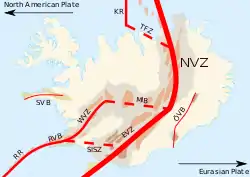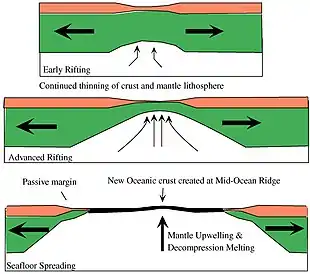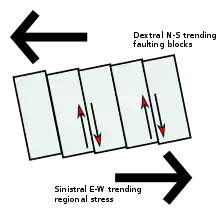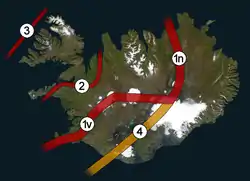Geological deformation of Iceland | |
|---|---|
Land deformation | |
.jpg.webp) Extensional structure, Þingvellir Graben, provides evidence for plate divergence in Iceland. | |
 Fig 1. This figure shows the locations of the major deformation zones in Iceland. The thickest line represents the divergent plate boundary. Legend: RR, Reykjanes Ridge; RVB, Reykjanes volcanic belt; WVZ, West volcanic zone; MIB, Mid-Iceland belt; SISZ, South Iceland seismic zone; EVZ, East volcanic zone; NVZ, North volcanic zone; TFZ, Tjörnes fracture zone; KR, Kolbeinsey Ridge; ÖVB, Öræfajökul volcanic belt; SVB, Snæfellsnes volcanic belt. The legend for the basalt regions is the same as below. | |
| Age | |
| Formed by | Tectonic forces |
| Area | |
| • Total | 102,775 km2 (39,682 sq mi) |
| Volcanic arc/belt | Mid-Atlantic Ridge, Iceland hotspot |
| Last eruption | 2024 |

The geological deformation of Iceland is the way that the rocks of the island of Iceland are changing due to tectonic forces. The geological deformation explains the location of earthquakes, volcanoes, fissures, and the shape of the island. Iceland is the largest landmass (102,775 km2 (39,682 sq mi)) situated on an oceanic ridge.[1]: 35 It is an elevated plateau of the sea floor, situated at the crossing of the Mid-Atlantic Ridge and the Greenland-Iceland-Scotland ridge.[2]: 59 It lies along the oceanic divergent plate boundary of North American Plate and Eurasian Plate. The western part of Iceland sits on the North American Plate and the eastern part sits on the Eurasian Plate. The Reykjanes Ridge of the Mid-Atlantic ridge system in this region crosses the island from southwest and connects to the Kolbeinsey Ridge in the northeast.[1]: 39, 40, 49
Iceland is geologically young: all rocks there were formed within the last 25 million years.[2] It started forming in the Early Miocene sub-epoch, but the oldest rocks found at the surface of Iceland are from the Middle Miocene sub-epoch. Nearly half of Iceland was formed from a slow spreading period from 9 to 20 million years ago (Ma).[2]
The geological structures and geomorphology of Iceland are strongly influenced by the spreading plate boundary and the Iceland hotspot. Although some have questioned if a hotspot is necessary to explain the observed deformations of Iceland this is currently felt to best explain observations of rock composition and age obtained by modern techniques.[3] The buoyancy of the deep-seated mantle plume underneath has uplifted the Iceland basalt plateau to as high as 3,000 m (9,800 ft). The hotspot also produces high volcanic activity on the plate boundary.[1]: 50
There are two major geologic and topographic structural trends in Iceland. One strikes north-east in southern Iceland and strikes nearly north in northern Iceland. The other one strikes approximately west to north-west. Altogether they produce a zigzag pattern. The pattern is shown by faults, volcanic fissures, valleys, dikes, volcanoes, grabens and fault scarps.[2]
Deformation of Iceland
The geological deformation of Iceland is mainly caused by the active spreading of the mid-oceanic ridge. Extensional cracks and transform faults are found perpendicular to the spreading direction.[1]: 50 The transform-fault zones are also known as fracture zones. These fracture zones allow large volumes of lava to be erupted. On the surface of Iceland, linear volcanic fissures formed along the rifts and appear in a swarm-like pattern. They are connected by fracture zones, forming the volcanic zones.[2]
Plate boundary deformation zones
Crustal movements have created two plate boundary deformation zones between the major plates, the North American Plate and the Eurasian Plate.[1]: 38–39
In northern Iceland, the width of the deformation zone is about 100 km (62 mi) wide.[1]: 38 It accumulates strain which come from rifting episodes and larger earthquakes.[1]: 38 This is manifest as the Tjörnes fracture zone (TFZ) off the northern coast.[1]: 40, 49
Hreppar microplate
In southern Iceland, the block located along the plate boundary is identified as a microplate, and is named the Hreppar block or Hreppar microplate.[1]: 53 Its current independent motion to the major plates was confirmed by GPS measurement.[1]: 52 Internal block deformation is negligible since it has no significant evidence of active deformation, earthquakes or volcanism and a propagating rift origin from the Eastern volcanic zone (EVZ) is proposed with the Western volcanic zone (WVZ) being the receding rift.[1]: 53 The northern boundary of the block is linked to the Mid-Iceland belt (MIB), where diffuse volcanism occurs. The southern boundary of the block is termed the South Iceland seismic zone (SISZ), where strike-slip earthquakes can occur.[1]: 38, 41
Transform fault zones
There are two major and active transform faults zones striking west to north-west in northern and southern Iceland.[4] Two large fracture zones, associated with the transform faults, namely the TFZ and SISZ are found striking about 75°N to 80°W.[5]
Bookshelf faulting

Stress is built up during the spreading movements at the plate boundary. The accumulated stress in transform fault zones is released during strike-slip earthquakes. The transform fault is induced by strike-slip motion that is transverse to the fault zone. The blocks between the faults are slightly rotated afterwards. A diagram (fig.2) is shown to illustrate this phenomenon. Since the rotation of the blocks is similar to a line of books leaning on a bookshelf, it is termed "bookshelf faulting".[1]: 41
Bookshelf faulting is an indicator of the young geological history of the fault zones. It is common in the SISZ and Reykjanes area.
Other evidence
Besides bookshelf faulting, the presence of the Icelandic fault zones are supported by seismological evidence. In Iceland, deformation usually concentrates over a zone of finite width. Thus, earthquakes usually occur along the active fracture zones between ridge crests.[4] Most earthquake activity in Iceland is focused in the transform faulting zones near the north and south coast.
Tjörnes fracture zone
The Tjörnes fracture zone (TFZ) is a tectonically complicated area. It is perhaps best regarded as a trans-tensional zone with transform faulting and spreading.[6] The TFZ is defined seismologically as an approximate triangle with apex about 67°N, sides 120 km (75 mi) and base of 150 km (93 mi) off the north coast of Iceland, connecting the north Iceland volcanic zone (NVZ) and the southern end of the Kolbeinsey Ridge.[7]: 117 This broad fracture zone is characterised by seismic activity, crustal extension and transform faulting.[1]: 49–50 The volcanic fissure swarms of the NVZ are connected to the southern end of TFZ. For example, its south-east end is connected to the Krafla fissure swarm.
The main structural components of the TFZ can be divided into three parts which trend from north-west to south-east, the Grímsey seismic zone, the Húsavík-Flatey fault zone and the Dalvík seismic zone.[7][1]: 49–50 The TFZ shows a huge spatial difference in seismic activity. For example, the westernmost part of the TFZ shows seismic activity, but a few larger earthquakes (>M=5.5) also appear in the zone.[7] MS7 earthquakes have occurred in the Dalvík zone.[1]: 50
The complexity in the TFZ can be generally explained by the magmatic processes and plate motions. The velocity of the divergent plate motion, estimated to be 18.9 ± 0.5 mm (0.744 ± 0.020 in)/year is strongly affected by the Icelandic mantle plume underneath central Iceland.[8] Volcanic activity can be found in the Dalvík seismic zone and southern tip of the Kolbeinsey Ridge.[9]
South Iceland seismic zone
The South Iceland seismic zone (SISZ), also known as the Reykjanes fracture zone(s), is 75 to 100 km (47 to 62 mi) wide, and strikes northeast to south-west in south-western Iceland. There are several approximately 40 km (25 mi) right lateral offsets of the ridge crest. The offsets create a transform fault zone connecting the EVZ and the Reykjanes volcanic belt.[4]
There is a significant change in the age and lithology of the volcanoes in a north-south direction near Reykjanes Peninsula due to bookshelf faulting. Bookshelf faulting is common in the SISZ. Since the transform motion in the SISZ is left-lateral, right-lateral faulting would occur and rotation of blocks would appear counter-clockwise. The sequential occurrence of major earthquakes in the SISZ provided evidence of bookshelf faulting. Within a single event, earthquakes begin in the eastern part of the SISZ with larger magnitudes and end up with smaller magnitudes in western part of the zone.[1]: 43 [4]
In the transform fault zones of Iceland, earthquakes usually occur on small scales (micro-earthquakes) due to plate straining and pore fluid pressure. Pore pressure increase can induce seismicity. A large amount of pore fluid pressure migrates from the brittle–ductile transition zone at about 10 km (6.2 mi) to the lithostatic/hydrostatic boundary at 3 km (1.9 mi) depth.[7] Large scale seismic activity is triggered if the pressure cannot pass through the transition zone. Small scale earthquakes are also released locally in or above the migration path.[7]
In 2000, two large earthquakes (see 2000 Iceland earthquakes) at Mw6.5 occurred in the SISZ.[10][11] During these events, additional small scale earthquakes concentrated narrowly and linearly around the transform fault planes.[1][12] Thus, with the same method, small scale earthquakes are also used to identify fault planes in the TFZ. These were followed by the slightly smaller 2008 Iceland earthquake.
Volcanic rift zones

Many of the volcanoes of Iceland can be grouped by their relationship to rift zones and contribute to the understanding of the deformation that has taken place. Not all the names used to classify the volcanoes into groups are yet standardised and not all the volcanic and tectonic relationships are well characterised due to issues such as accessibility or less current activity.
Rift jump model
The evolution of the Icelandic volcanic rift zones can be explained by the rift jump model.[13]
Synform folding is expected to occur at the active rift axis. However, distinctive reversals in dip directions are found in south-western Iceland which indicate an anticline. It is believed that the relative positions of the Icelandic hot spot and the active rift spreading axis have changed with time. Assuming the Icelandic mantle plume is stationary, the spreading axis must have changed position.[13]
At least part of the spreading axis migrates at a rate of about 3.5–5 cm/year (1.4–2.0 in/year).[14]: 17512 After the active spreading axis has moved away from the plume, the mantle plume would adjust the position of the axis and forms a new rift closer to its centre. The migrated axis would gradually become extinct.[2]: 67
There are three major volcanic zones in Iceland, which are the Northern, Eastern and Western volcanic zones (NVZ, EVZ, WVZ), and all of which are currently active. The volcanic rift zones cross the island from south-west to north-east. Each zone consists of 20–50 km (12–31 mi) wide belts and is characterised by active volcanoes, numerous normal faults, a high temperature geothermal field and fissure swarms.[15] The EVZ will eventually take over the WVZ according to the rift jump process.[1]: 35, 54

Northern volcanic zone
The 50 km (31 mi) wide Northern volcanic zone (NVZ, North volcanic zone of Iceland, Northern rift zone)[16] is composed of five volcanic systems arranged zigzag-like along the mid-Atlantic plate boundary.[1]: 46–49 It shows quite low seismic activity. The volcanic activity is confined to the Krafla central volcano and its associated fissure swarms.[4] It accommodates the entire rifting of North Iceland and can be regarded at the present time to be in a steady state of spreading rate.[3] There is a greater predominance of lava shields than in the other active rifting areas.[1]: 46–47 The Icelandic shield volcanoes that produced these large lava fields here and in the WVZ did so in a single almost continuous eruptive process that is distinct from the repeated discontinuous eruptions often seen in shield volcanoes elsewhere in the world and that would earn them the classification as a central volcano in the Iceland geological context.[17]: 11–12
The Krafla central volcano is not distinctive within the volcanic rift zone. Fissure swarms of the Krafla spread away from the magma chamber and magma flows along the swarms to the north and south of the volcano. Eruptive fissures within the fissure swarms are most common within 20–30 km (12–19 mi) distance from the central volcanoes. Fractures within the fissure swarms are common at up to a distance of 70–90 km (43–56 mi) from the central volcano.[4]
Fractures within the fissure swarms are generally subparallel to each other. Irregular fracture patterns are found where the Húsavík transform fault meets the fissure swarms, which indicates interaction between the fissure swarms and the strike-slip faults.[4]
The division between the NVZ and the EVZ is arbitrary, as the rifting structures are a single continuous structural identity.[3] The North Iceland last major rift relocation occurred about 6 to 7 million years ago when the northern now extinct Snæfellsnes-Húnaflói rift zone (SHRZ),[18] shifted eastward to the new rift axis in the NVZ.[3] There is with new dating techniques accurate understanding of SHRZ history from the north western region of Iceland to the north eastern that was not available when the SHRZ was first described.[3]

Eastern volcanic zone
The Eastern volcanic zone (EVZ, East volcanic zone of Iceland) is located in south-east Iceland and has high volcanic activity.[1]: 46 It connects to the SISZ and NVC in its western and northern end respectively. Seismic activity focuses in the Vatnajökull Glacier area which is the accepted location of the Icelandic hot spot.[1]: 46 The EVZ started forming between 1.5 to 3 million years ago as a result of NVZ southward propagation.[16]: 2 It is the eastern boundary of the Hreppar microplate.
Deformed structures, including the dominant north-east trending eruptive fissure swarms and volcanic structures,[1]: 46 and some normal fault structures, can be found in EVZ.[19] Long hyaloclastite ridges, formed by subglacial eruptions during the last glacial period, are distinctive structures in the EVZ. Compared with WVZ, eruptive fissure swarms and hyaloclastite ridges are generally longer in the EVZ.[1]: 46 During the past glacial period, a huge volume of basaltic eruptions occurred, producing the long volcanic fissure swarms. The EVZ is geologically young, as mentioned above, the EVZ will eventually take over the WVZ according to the rift jump process model.[1]: 54
The southern EVZ is propagating to the south-west through older Eurasian Plate crust.[3] This results in active volcanism and rifting.
Western volcanic zone
The Western volcanic zone (WVZ, West volcanic zone of Iceland) is located to the north of the SISZ, where its northern end connects to the Langjökull area.[1]: 44–5 It has been the active propagating rift in the last 7 million years,[18] but is now regarded as waning in active rift activity as the hotspot shifts eastward,[3] and with the re-classification of the active volcanoes of the Reykjanes Peninsula from the WVZ to the Reykjanes volcanic belt (RVB) which is now regarded as a trans-tensional zone with transform faulting and spreading.[6] Structures related to normal faulting are much more apparent than in the younger EVZ.[1]: 46 The WVZ initially took over as the principle plate boundary in Iceland about 6 million years ago from its predecisor the Snæfellsnes Rift, which then connected western Iceland to north Iceland.[16]: 2 During this period of activity it was known as the Reykjanes-Langjökull rift zone which propagated to the south-west.[16]: 2 Until 2 million years ago the seafloor spreading around Iceland was accommodated by this rift zone, an ill defined transferse connecting zone between it and the NVZ and the NVZ.[16]: 2 As the EVZ became active the Reykjanes-Langjökull rift zone became todays WVZ. The WVZ remains active despite being an ultraslow spreading center with extension rates of 0.3–0.7 cm/year (0.12–0.28 in/year) which is 20–30% of the total opening across south Iceland.[16]: 3
In the northern part of the WVZ, normal faulting is still common but volcanic fissures become less dominant and active. The WVZ is the western boundary of the Hreppar microplate.
Shield volcanoes are also observed in this zone. The Þingvellir Graben is evidence of divergent plate movement in Iceland. It shows a clear extensional feature.[1]: 44 It is located to the north of the plate triple junction manifest as the intersection of the WVZ, RVB and SISZ near the Hengill volcano.[20]
Mid-Iceland belt
The Mid-Iceland belt (MIB, Central Iceland volcanic zone, CIVZ, Mid-Iceland zone, Hofsjökull zone)[16] of volcanoes, connects the WVZ to the intersection region of the NVZ and EVZ. It is parallel to the north of the SISZ and has a relationship to its transform nature. There is a small component of extension, that induces local volcanism but has no obvious strike-slip movement.[3] The extension component has been proposed to be caused by the opposite sense of rotation of crustal blocks to the north, which is in the Eurasian Plate and the Hreppar microplate to the south.[3] It is thus the northern boundary of the Hreppar microplate as already mentioned. Both volcanic and seismic activity has be low in the Holocene.[1]: 46
Intra-plate deformation
This is manifest as volcanic belts separate to the rift associated zones above. In the case of the Öræfi volcanic belt it is considered to be an embryonic rift, a process likely to be repeating past events with the southern part of the NVZ as an embryonic rift millions of years ago given rift zone jumping.[21]
Snæfellsnes volcanic belt
The Snæfellsnes volcanic belt (SVB) is an area of renewed intra-plate volcanism through the western aspects of the extinct SHRZ that is a predecessor to the present MIB when the WVZ had the hotspot directly under it and prior to historic rift zone jumping.[3] The SVB comprises the stratovolcanoes of Snæfellsjökull, Helgrindur (Lýsuskarð) and Ljósufjöll in a peninsular east to west lineament.[22]
Öræfi volcanic belt
The Öræfi volcanic belt (OVB, other names include Öræfajökull-Snæfell volcanic belt and the Öræfajökull volcanic system or belt) is to the east and parallel to the EVZ.[3] Its three component central volcanoes of Öræfajökull, Esjufjöll, and Snæfell are in a south-west to north-east trending lineament and have rhyolite through to alkalic erupted basalts.[23]
See also
References
- 1 2 3 4 5 6 7 8 9 10 11 12 13 14 15 16 17 18 19 20 21 22 23 24 25 26 27 28 29 30 Einarsson, P. (2008). "Plate boundaries, rifts and transforms in Iceland". Jökull. 58 (12): 35–58.
- 1 2 3 4 5 6 Árnadóttir, T.; Geirsson, H.; Jiang, W. (2008). "Crustal deformation in Iceland: Plate spreading and earthquake deformation". Jökull. 58: 59–74.
- 1 2 3 4 5 6 7 8 9 10 11 Árnadóttir, S.; Thordarson, T.; Hjartarson, Á.; Gautason, B. (2023). "U–Pb zircon age and chronology of the Torfufell central volcano: implications for timing of rift relocation in North Iceland". Bulletin of Volcanology. 85 (52): 1–17. doi:10.1007/s00445-023-01667-8.: Introduction, pages 1-3
- 1 2 3 4 5 6 7 Einarsson, P. (1991). "Earthquakes and present-day tectonism in Iceland". Tectonophysics. 189 (1–4): 261–279. Bibcode:1991Tectp.189..261E. doi:10.1016/0040-1951(91)90501-I.
- ↑ Ward, P. L. (1971). "New Interpretation of the Geology of Iceland". Geological Society of America Bulletin. 82 (11): 2991–3012. doi:10.1130/0016-7606(1971)82[2991:NIOTGO]2.0.CO;2.
- 1 2 Sæmundsson, K.; Sigurgeirsson, M.Á.; Friðleifsson, G.Ó. (2020). "Geology and structure of the Reykjanes volcanic system, Iceland". Journal of Volcanology and Geothermal Research. 391 (106501). doi:10.1016/j.jvolgeores.2018.11.022.: Introduction
- 1 2 3 4 5 Stefansson, R.; Gudmundsson, G. B.; Halldorsson, P. (February 2008). "Tjörnes fracture zone. New and old seismic evidences for the link between the North Iceland rift zone and the Mid-Atlantic ridge". Tectonophysics. 447 (1–4): 117–126. Bibcode:2008Tectp.447..117S. doi:10.1016/j.tecto.2006.09.019.
- ↑ Stefánsson, R.; Halldórsson, P. (September 1988). "Strain release and strain build-up in the south Iceland seismic zone". Tectonophysics. 152 (3–4): 267–276. Bibcode:1988Tectp.152..267S. doi:10.1016/0040-1951(88)90052-2.
- ↑ Riedel, C.; Schmidt, M.; Botz, R.; Theilen, F. (December 2001). "The Grimsey hydrothermal field offshore North Iceland: crustal structure, faulting and related gas venting". Earth and Planetary Science Letters. 193 (3–4): 409–421. Bibcode:2001E&PSL.193..409R. doi:10.1016/S0012-821X(01)00519-2.
- ↑ "M 6.5 - 25 km E of Selfoss, Iceland". earthquake.usgs.gov. United States Geological Survey. Retrieved 2024-01-01.
- ↑ "M 6.5 - 12 km ENE of Selfoss, Iceland". earthquake.usgs.gov. United States Geological Survey. Retrieved 2024-01-01.
- ↑ Stefánsson, R., Guðmundsson, G. B., & Roberts, M. J. (2006). Long-term and short-term earthquake warnings based on seismic information in the SISZ. Veðurstofa Íslands.
- 1 2 Sæmundsson, K. (1974). "Evolution of the Axial Rifting Zone in Northern Iceland and the Tjörnes Fracture Zone". Geological Society of America Bulletin. 85 (4): 495–504. Bibcode:1974GSAB...85..495S. doi:10.1130/0016-7606(1974)85<495:EOTARZ>2.0.CO;2.
- ↑ Foulger, G.R.; Toomey, D.R. (1989). "Structure and evolution of the Hengill‐Grensdalur Volcanic Complex, Iceland: Geology, geophysics, and seismic tomography". Journal of Geophysical Research: Solid Earth. 94 (B12): 17511–17522. Bibcode:1989JGR....9417511F. doi:10.1029/JB094iB12p17511.
- ↑ Flóvenz, Ó. G.; Saemundsson, K. (1993). "Heat flow and geothermal processes in Iceland". Tectonophysics. 225 (1–2): 123–138. Bibcode:1993Tectp.225..123F. doi:10.1016/0040-1951(93)90253-G.
- 1 2 3 4 5 6 7 Sinton, J.; Grönvold, K; Sæmundsson, K. (2005). "Postglacial eruptive history of the western volcanic zone, Iceland". Geochemistry, Geophysics, Geosystems. 6 (12): 1–34.
- ↑ Andrew, R. E. B. (2008). PhD Dissertation: Volcanotectonic Evolution and Characteristic Volcanism of the Neovolcanic Zone of Iceland (PDF) (Thesis). Georg-August-Universität, Göttingen. pp. 1–122. Archived from the original (PDF) on 2012-03-09. Retrieved 2011-05-24.
- 1 2 Kristjánsson, L.; Jónsson, G. (1998). "Aeromagnetic results and the presence of an extinct rift zone in western Iceland". Journal of Geodynamics. 25 (1–2): 99–108. Bibcode:1998JGeo...25...99K. doi:10.1016/S0264-3707(97)00009-4.
- ↑ Þórarinsson, S., Sæmundsson, K., & Williams, R. S. (1973). ERTS-1 image of Vatnajökull: analysis of glaciological, structural, and volcanic features.
- ↑ Decriem, J.; Árnadóttir, T.; Hooper, A.; Geirsson, H.; Sigmundsson, F.; Keiding, M.; Ófeigsson, B. G.; Hreinsdóttir, S.; Einarsson, P.; LaFemina, P.; Bennett, R. A. (2010). "The 2008 May 29 earthquake doublet in SW Iceland". Geophysical Journal International. 181 (2): 1128–1146. Bibcode:2010GeoJI.181.1128D. doi:10.1111/j.1365-246x.2010.04565.x.: 1128
- ↑ Árnadóttir, S.; Thordarson, T.; Hjartarson, Á.; Gautason, B. (2023). "U–Pb zircon age and chronology of the Torfufell central volcano: implications for timing of rift relocation in North Iceland". Bulletin of Volcanology. 85 (52): 1–17. doi:10.1007/s00445-023-01667-8.: Discussion, pages 11-14
- ↑ Jóhannesson, Haukur (2019). "Catalogue of Icelandic Volcanoes - Snæfellsjökull". Icelandic Meteorological Office, Institute of Earth Sciences at the University of Iceland, Civil Protection Department of the National Commissioner of the Iceland Police. Retrieved 3 January 2024.
- ↑ Höskuldsson, Ármann (2019). "Catalogue of Icelandic Volcanoes - Öræfajökull". Icelandic Meteorological Office, Institute of Earth Sciences at the University of Iceland, Civil Protection Department of the National Commissioner of the Iceland Police. Retrieved 6 January 2023.: Detailed Description:1. Geological setting and tectonic context
